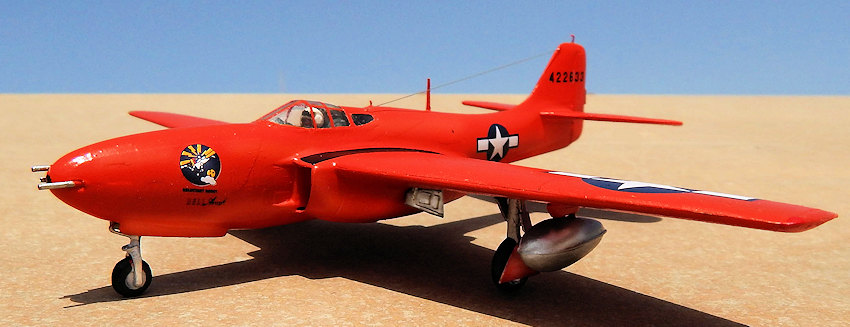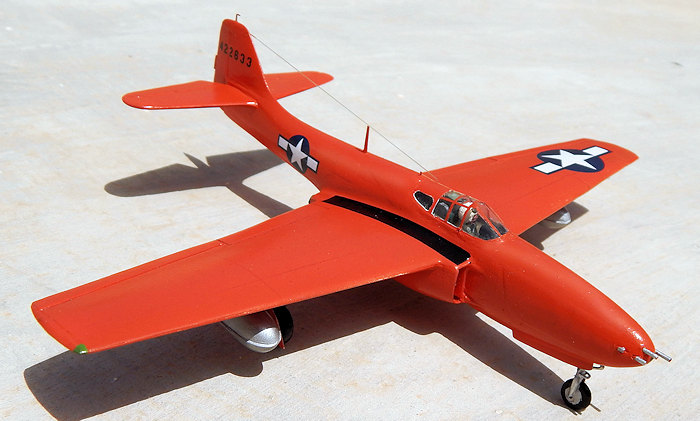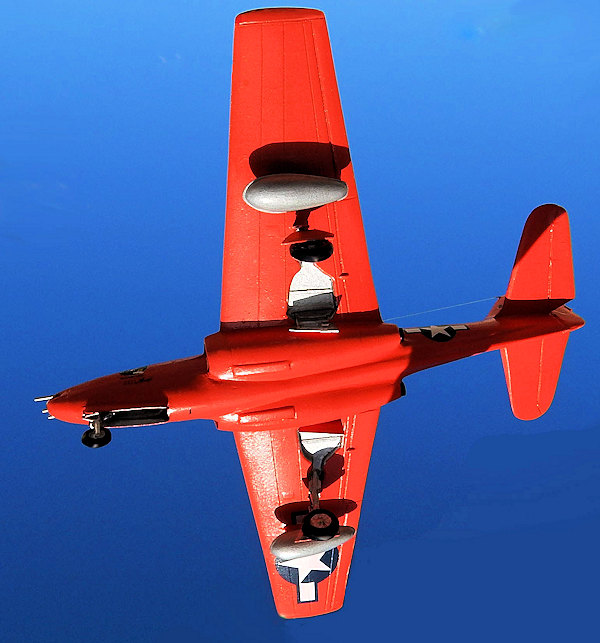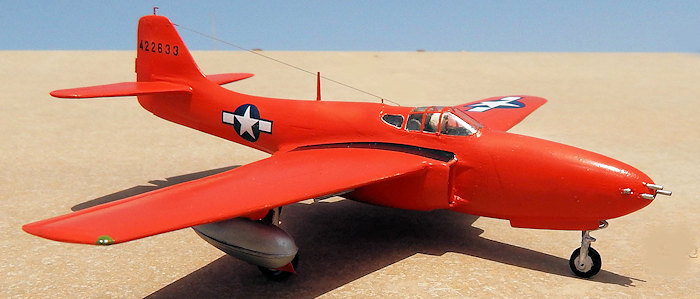
Rareplanes 1/72 P-59B Airacomet
| KIT #: | |
| PRICE: | $ |
| DECALS: | None |
| REVIEWER: | Carmel J. Attard |
| NOTES: | Vacuform kit |

| HISTORY |
This is an example of America’s first jet. On 12
September 1942, the first XP-59A was sent to Muroc Army Air Field (today,
Eduards Air Force Base) in California by train for testing, taking seven days to
reach Muroc. While being handled on the ground, the aircraft was fitted with a
dummy propeller to disguise its t rue
nature. The aircraft first became airborne during high-speed taxiing tests on 1
October with Bell test pilot Robert Stanley at the controls, although the first
official flight was made by Col Laurence Craigie the next day.
A handful of the first Airacomets
had open-air flight observer stations (similar to those of biplanes) later cut
into the nose; over the following months, tests on the three XP-59As revealed a
multitude of problems including poor engine response and reliability (common
shortcomings of all early turbojets), insufficient lateral stability, i.e., in
the roll axis,
and performance that was far below expectations.
Chuck Yeager flew the aircraft and was dissatisfied with its speed, but was
amazed at its smooth flying characteristics. Nevertheless, even before delivery
of the YP-59As in June 1943, the USAAF ordered 80 production machines,
designated "P-59A Airacomet".
rue
nature. The aircraft first became airborne during high-speed taxiing tests on 1
October with Bell test pilot Robert Stanley at the controls, although the first
official flight was made by Col Laurence Craigie the next day.
A handful of the first Airacomets
had open-air flight observer stations (similar to those of biplanes) later cut
into the nose; over the following months, tests on the three XP-59As revealed a
multitude of problems including poor engine response and reliability (common
shortcomings of all early turbojets), insufficient lateral stability, i.e., in
the roll axis,
and performance that was far below expectations.
Chuck Yeager flew the aircraft and was dissatisfied with its speed, but was
amazed at its smooth flying characteristics. Nevertheless, even before delivery
of the YP-59As in June 1943, the USAAF ordered 80 production machines,
designated "P-59A Airacomet".
The 13 service test YP-59As had a more
powerful engine than its predecessor, the General Electric J31, but the
improvement in performance was negligible with top speed increased by only 5 mph
and a reduction in the time they could be used before an overhaul was needed.
One of these aircraft, the third YP-59A (S/n:42-22611)
was supplied to the Royal Air Force (receiving British serial
RG362/G), in exchange for the
first productio n
Gloster Meteor I, EE210/G.
British pilots found that the aircraft compared very unfavorably with the jets
that they were already flying. (The YP-59A also compared unfavorably to the
propeller-driven North American P-51 Mustang. Two YP-59A Airacomets (42-108778
and 42-100779) were also
delivered to the U.S. Navy where they were evaluated as the "YF2L-1" but quickly
found completely unsuitable for carrier operations.
n
Gloster Meteor I, EE210/G.
British pilots found that the aircraft compared very unfavorably with the jets
that they were already flying. (The YP-59A also compared unfavorably to the
propeller-driven North American P-51 Mustang. Two YP-59A Airacomets (42-108778
and 42-100779) were also
delivered to the U.S. Navy where they were evaluated as the "YF2L-1" but quickly
found completely unsuitable for carrier operations.
Faced with their own ongoing difficulties, Bell eventually completed 50 production Airacomets, 20 P-59As and 30 P-59Bs. Each was armed with one 37 mm M4 cannon and 44 rounds of ammunition and three .50 cal (12.7 mm) machine guns with 200 rounds per gun. The P-59Bs were assigned to the 412th Fighter Group to familiarize AAF pilots with the handling and performance characteristics of jet aircraft. By 1950, all examples of the Airacomet were no longer airworthy. Over time, disposal of the aircraft included use as static displays, instructional aids in military training and use as static targets. While the P-59 was not a great success, the type did give the USAAF experience with the operation of jet aircraft in preparation for the more advanced types that would shortly become available.
| THE KIT |
This is in fact one of the earlier Rareplanes kits but was acquired recently from a modeler (from Colorado Springs) a contact who visited me quite recently. Not surprisingly being a short run vac-form kit it was a type that one should expect to do a lot of extra work on it. I first did some research on the kit itself which indicated that there is a more recent issue of the model by Special Hobby in injected form but still I thought it looked accurate to me and decided to make a start on it and this should add another to my Rareplanes lot.
| CONSTRUCTION |
I have managed to download several
photos of the early production aircraft along with close up photos of museum
examples. Armed with good reference and good scale plans that comes with the
Rareplanes kit I started cutting the vac parts and each sanding down to the
required shape by frequent checking as I did with vac kits over the years. The
kit made out of white styrene is soft and easy to sand and drill. The kit parts
comformed very close to the 1/72 scale plans provided. There were however some
areas that required detailing and these included finding a good replacement crew
seat, detailing the cockpit interior, cockpit floor, column. Instrument boxes at
back of seat and coaming. There was only one cockpit canopy and careful cutting
and gentle trimming since it comes in vac form is essential. The nose area
contained plenty of room to house in lead weight ( around 28 grams) so that it will balance on the nose
gear. I also trimmed and added detail to the undercarriage gears. Some visible
detail was also added to the wheel wells.
house in lead weight ( around 28 grams) so that it will balance on the nose
gear. I also trimmed and added detail to the undercarriage gears. Some visible
detail was also added to the wheel wells.
There was major omission in detail to the air intake interior that should keep them firm in section. A sufficiently slim airfoil shape is obtained on the flying surfaces before attempting to cement the wing parts together. The wings were butt jointed at the root/engine area forming a complete fuselage structure. A fair amount of filler was needed at the underside seam which was smoothened and given a matt gray coat to expose any blemishes that still were present. Tail planes were glued together and a small diameter metal rod was passed through the tail fin section that was to hold the tail planes correctly level and aligned when fixed in place. A pair of exhaust pipes that were formed from a short stem of round runner piece, drilled at its centre, and added to the engine exhaust area. A pair of wing mounted fuel tanks issued with the kit were fitted. These were mounted to a set of pylons borrowed from a Mustang Airfix kit. Wheel well doors were built from laminated plastic card so that the detail on the inside was shaped separately.
| COLORS AND MARKINGS |
 Thanks to
Special Hobby whose kit contained a decal option that I could use from their kit
release. I picked one of the 30 P-59B built. This was international orange
overall which originally carried a long probe but I opted to alter the nose
assuming it carried in later life the same standard armament of a machine gun
and three gun positions. Wheel wells appeared to be silver and the model was
airbrushed in satin white base coat and finally given a coat of Pactra
International orange. This was followed by a coat of Future in preparation to
apply decals. For the wing walk ways I used black decal strips cut to required
size. No anti glare panel appeared to be applied on this particular color
scheme. Engine exhaust pipes were painted black. I added an antenna at dorsal
fuselage area and also a wireless from fin to rear of cockpit using a length of
invisible thread.
Thanks to
Special Hobby whose kit contained a decal option that I could use from their kit
release. I picked one of the 30 P-59B built. This was international orange
overall which originally carried a long probe but I opted to alter the nose
assuming it carried in later life the same standard armament of a machine gun
and three gun positions. Wheel wells appeared to be silver and the model was
airbrushed in satin white base coat and finally given a coat of Pactra
International orange. This was followed by a coat of Future in preparation to
apply decals. For the wing walk ways I used black decal strips cut to required
size. No anti glare panel appeared to be applied on this particular color
scheme. Engine exhaust pipes were painted black. I added an antenna at dorsal
fuselage area and also a wireless from fin to rear of cockpit using a length of
invisible thread.
| CONCLUSIONS |
In conclusion this was quite a nice kit that took longer to build and had a few minor construction problems to overcome and it fits well to other research USAF aircraft types that I have made.
23 May 2016
Copyright ModelingMadness.com If you would like your product reviewed fairly and fairly quickly, please
contact
the editor or see other details in the
Note to
Contributors.